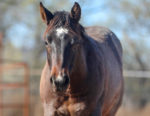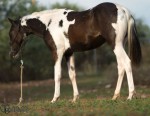
With the breeding season soon approaching an issue that is of big importance to me is knowing what I am breeding to. As we all hope for that “perfect” foal I feel that as a breeder, especially if you stand your stud out to the public, it is important to know the results of various genetic diseases that your stallion could possibly have. I do not feel that you have to rule a stallion out if they test to be a carrier but you should breed responsibly. Also be sure to know what your mares genetic test results are so you can make the right choice.

HERDA ~ heredity equine regional dermal asthenia.
Hereditary equine regional dermal asthenia (HERDA) is a genetic skin disease predominantly found in the American Quarter Horse. Within the breed, the disease is prevalent in particular lines of cutting horses. HERDA is characterized by hyperextensible skin, scarring, and severe lesions along the back of affected horses. Affected foals rarely show symptoms at birth. The condition typically occurs by the age of two, most notably when the horse is first being broke to saddle. There is no cure, and the majority of diagnosed horses are euthanized because they are unable to be ridden and are inappropriate for future breeding. HERDA has an autosomal recessive mode of inheritance and affects stallions and mares in equal proportions. Research carried out in Dr. Danika Bannasch’s laboratory at the University of California, Davis, has identified the gene and mutation associated with HERDA.
The diagnostic DNA test for HERDA that has been developed allows identification of horses that are affected or that carry the specific mutation. Other skin conditions can mimic the symptoms of HERDA. The DNA test will assist veterinarians to make the correct diagnosis. For horse breeders, identification of carriers is critical for the selection of mating pairs. Breedings of carrier horses have a 25% chance of producing an affected foal. Breedings between normal and carrier horses will not produce a HERDA foal although 50% of the foals are expected to be carriers.
HYPP ~ Hyperkalemic periodic paralysis
Hyperkalemic periodic paralysis (HYPP) is an inherited disease of the muscle which is caused by a genetic defect. In the muscle of affected horses, a point mutation exists in the sodium channel gene and is passed on to offspring.
Sodium channels are “pores” in the muscle cell membrane which control contraction of the muscle fibers. When the defective sodium channel gene is present, the channel becomes “leaky” and makes the muscle overly excitable and contract involuntarily. The channel becomes “leaky” when potassium levels fluctuate in the blood. This may occur with fasting followed by consumption of a high potassium feed such as alfalfa. Hyperkalemia, which is an excessive amount of potassium in the blood, causes the muscles in the horse to contract more readily than normal. This makes the horse susceptible to sporadic episodes of muscle tremors or paralysis.
This genetic defect has been identified in descendents of the American Quarter Horse sire, Impressive. The original genetic defect causing HYPP was a natural mutation that occurred as part of the evolutionary process. The majority of such mutations, which are constantly occurring, are not compatible with survival. However, the genetic mutation causing HYPP produced a functional, yet altered, sodium ion channel. This gene mutation is not a product of inbreeding. The gene mutation causing HYPP inadvertently became widespread when breeders sought to produce horses with heavy musculature. To date, confirmed cases of HYPP have been restricted to descendants of this horse.
For some more information about HYPP CLICK HERE
PSSM ~ polysaccharide storage myopathy
Polysaccharide storage myopathy (PSSM) is characterized by the abnormal accumulation of the normal form of sugar stored in muscle (glycogen) as well as an abnormal form of sugar (polysaccharide) in muscle tissue. Thousands of horses have been identified with tying-up associated with polysaccharide accumulation in muscles. There are two forms Type 1 and Type 2 PSSM. We know that both are the result of the accumulation of muscle glycogen which is the storage form of glucose in muscles.
Type 1 PSSM is caused by a mutation in the GYS1 gene. The mutation causing PSSM is a point mutation on the GYS1 gene which codes for the skeletal muscle form of the glycogen synthase enzyme. The cause of Type 2 PSSM has yet to be identified. Both types have an abnormal type of glycogen staining in muscle biopsies, and the types can be distinguished by genetic testing. Horses with Type 2 PSSM lack the mutation that is specific for Type 1 PSSM. At present there is not a specific genetic test for type 2 PSSM and we do not have conclusive evidence that it is inherited.
Carbohydrates that are high in starch, such as sweet feed, corn, wheat, oats, barley, and molasses, appear to exacerbate type 1 and type 2 PSSM. That is why they should be avoided and extra calories can be provided in the form of fat. An important part of the management of PSSM horses is daily exercise. This enhances glucose utilization, and improves energy metabolism in skeletal muscle. If only the diet is changed, we found that approximately 50% of horses improve. If both diet and exercise are altered, then 90% of horses have had no or few episodes of tying-up.
An old theory about tying-up is that it is due to too much lactic acid in the muscle. Many exercise studies have proven that this is absolutely not the case with PSSM. PSSM is actually a glycogen storage disease and there are several diseases in other species and in human beings that also result in the storage of too much glycogen in skeletal muscle. In these other diseases, glycogen accumulates because the muscle lacks an enzyme (protein) necessary to burn glycogen as an energy source. These similarities led us to test PSSM horses for the disorders in glycogen metabolism identified in human beings. We found that PSSM is a unique glycogen storage disease because the PSSM horses have all the necessary enzymes to burn glycogen as a fuel in their muscles. With exercise, PSSM horses show the expected decrease in muscle glycogen as it is burned as fuel.
The unique feature of PSSM is that the muscle cells in PSSM horses remove sugar from the blood stream and transported into their muscle at a faster rate, and make more glycogen than normal horses. Our recent research shows that the reason for this is that PSSM muscles are very sensitive to insulin beginning as early as 6 months of age. Insulin is a hormone released by the pancreas into the bloodstream in response to a carbohydrate meal. It stimulates the muscle to take up sugar from the bloodstream. Once inside the cell the muscle’s of PSSM horses make much more glycogen than a normal horse due to an overactive enzyme called glycogen synthase in the case of type 1 PSSM.
For more information on PSSM please CLICK HERE
MH ~ malignant hyperthermia
Equine malignant hyperthermia (EMH) is a dominant disease (one copy of the mutation is sufficient to produce disease) identified in Quarter Horses and American Paint Horses that can cause severe typing up and even death when horses are subjected to anesthesia.
It has been shown that a gene mutation in the calcium release channel causes a dysfunction in skeletal muscles resulting in excessive release of calcium inside the muscle cell. This triggers a series of events resulting in a hyper-metabolic state and/or death. Symptoms include fever, excessive sweating, elevated heart rate, abnormal heart rhythm, shallow breathing, muscle rigidity, and death with acute rigor mortis.
For more information about equine MH CLICK HERE
GBED ~ glycogen branching enzyme deficiency
Glycogen-branching enzyme disorder (GBED) has likely been a cause of neonatal mortality in Quarter Horses for decades, according to Stephanie Valberg, DVM, PhD, who gave an update on her research on the disorder at the recent conference of the American Quarter Horse Association, held March 11-14 in St. Louis, Mo. Additionally, she reported that all the known affected foals and carriers of GBED are descendants of the Quarter Horse sire Zantanon and his son King, and about 8% of King descendants are carriers of GBED. This fatal disease is seen in Quarter Horses and related breeds. The foals lack the enzyme necessary to store glycogen (sugars) in its branched form and therefore cannot store sugar molecules. This disease is fatal as the heart muscle, brain and skeletal muscles are unable to function.
Valberg and Jim Mickelson, PhD, associate professor veterinary pathobiology at the University of Minnesota College of Veterinary Medicine, identified GBED and described it to the public in 2004. The disease causes a wide variety of clinical signs, so it might be confused with other conditions. It can cause abortion or stillbirth.
Alternatively, foals can be weak at birth and need assistance to suck and stand. If helped through the first few days, foals might survive for up to two months. All foals diagnosed with GBED have died or had to be euthanatized because of muscular weakness by 18 weeks of age.
For more information on GBED take a look at THE HORSE
So with all that said I am super excited to say that First Deposit will be standing to the public in 2013 and came back N/N on all of the 5 tests. Let the breeding begin (-:

















